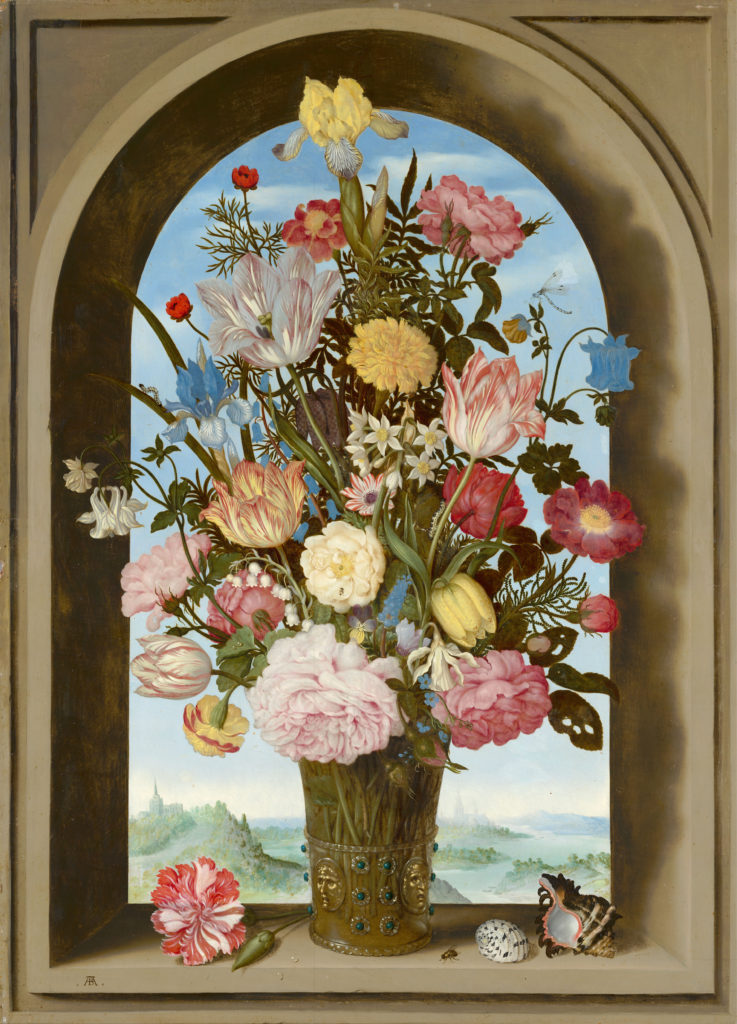Daniel A. Rabuzzi has had two novels, five short stories…

Let’s consider Vase of Flowers in a Window by Ambrosius Bosschaert the Elder, a classic Dutch still life, reproduced above. He has, in exquisite detail, rendered the likeness of some dozen flower species (he apparently knew several botanists where he worked in the Netherlands). At first glance, you might well think you are looking at an actual vase, through an actual window. As Hanneke Grootenboer notes about Dutch still life paintings generally: “The trompe-l’œil is a practical joke that provokes our eyes to the point of insult, and of doubt: the deceit undermines our reliance on our perceptions”1. With the painting above, the deceit goes further still. Its verisimilitude is matched by artifice: the species do not bloom at the same time, so the picture is actually impossible – and the mountain panorama in the background hardly looks Dutch. Bosschaert the Elder’s painting presents us with powerful truths about early 17th-century Dutch life, even as he elides certain facts and creates a composite memorial to one’s emotional history, aesthetic responses, to the act of remembering itself. Perhaps this – and the many similar Dutch still life paintings – are as much “trompe-la-mémoire” as trompe-l’œil.
We recognize that memory is selective, incomplete, a trickster by nature…yet we also know memory may present deeper or more relevant truths than seemingly more factual accounts. Bosschaert’s impossible vase of flowers is nevertheless accurate of many moments accreted, layered, stroked, then lacquered and waxed onto the canvas of our consciousness. The memory – not just of this tulip or that peony in this garden or that greenhouse – but the memories of how you felt when you gazed upon the flowers, your interpretations and comparisons, your desires and reminiscences of your anticipation even then of future encounters with other blooms. Bosschaert and his fellow artists were working within well-articulated traditions of Vanitas , Memento mori and Ars longa, vita brevis – philosophies stressing that life was fleeting, that time loitered for no one. What more eloquently demonstrates the ephemeral nature of beauty and of existence itself than the flower, the individual leaf and petal each in its season?
To simultaneously acknowledge and evade (if not overcome) evanescence, Bosschaert has given us a memory-garden: a hortus conclusus that attempts to stop and hold myriad moments in time, moments that otherwise glide and fly, having been lived(in) once, a collapsible series, petal upon petal, bract upon bract, the head of the aster repeating one form forever. As we gaze on the flowers, past is present is future: a 400-year-old image of species that have existed for millennia, experienced now (right now! As you read this!), overlaid with each viewer’s own memories of flowers observed and other paintings regarded, calqued with forebodings and/or excitement for potential returns to this painting, to other paintings, to the kinds of flowers depicted. I return now to the image at the top of page one, to Bosschaert’s flowers, and I ask my past self what most moved me then, and I ask myself now the same mutatis mutandis, and I preposition said question for my future self. What about you?2345
Daniel A. Rabuzzi has had two novels, five short stories and ten poems published since 2006 (see www.danielarabuzzi.com). He lived eight years in Norway, Germany and France. He has degrees in the study of folklore and mythology, international relations, and early modern European history. He lives in New York City with his artistic partner & spouse, the woodcarver Deborah A. Mills (http://www.deborahmillswoodcarving.com/), and the requisite cat.











